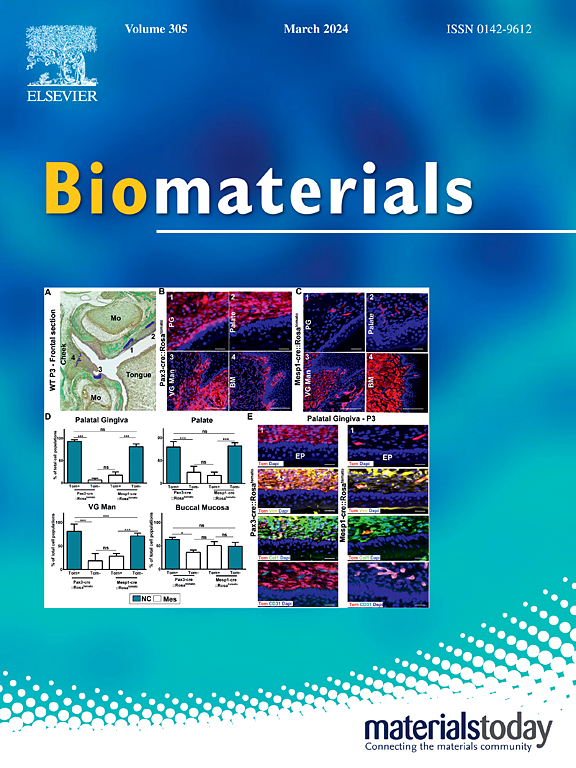Hydrogen generators-protected mesenchymal stem cells reverse articular redox imbalance-induced immune dysfunction for osteoarthritis treatment
IF 12.8
1区 医学
Q1 ENGINEERING, BIOMEDICAL
引用次数: 0
Abstract
Stem cell therapy has revolutionized the management of osteoarthritis (OA), but the articular dysregulated redox status diminishes cell engraftment efficiency and disrupts immune homeostasis, therefore compromising the overall therapeutic efficacy. Here, we present hydrogen (H2) generators-backpacked mesenchymal stem cells (MSCs) which preserve the biological functions and survival of transplanted cells and reverse articular immune dysfunction, mitigating OA. Specifically, post systemic transplantation, H2 generators-laden MSCs home to OA joints, and upon stimulation in acidic OA environment, H2 produced from the generators remodels articular redox balance, thereby relieving the loss of mitochondrial membrane potential, decreasing cell apoptosis rate, and maintaining pluripotent and paracrine functions of MSCs. Furthermore, the reactive oxygen species scavenging by H2 in combination with paracrine effects of the MSCs promote macrophage polarization towards the anti-inflammatory M2 phenotype, which contributes to reversing synovial immune disorder. In severe OA model, the backpacked MSCs reduce osteoarthritic degeneration, osteophyte formation and joint inflammation, and promote cartilage regeneration. In sum, our work demonstrates that arming with H2 generators effectively boosts the therapeutic efficacy of MSCs, which hold great potential for alleviating redox imbalance-related tissue lesions, including but not limited to OA.

氢发生器保护的间充质干细胞逆转关节氧化还原失衡引起的骨关节炎治疗免疫功能障碍
干细胞治疗已经彻底改变了骨关节炎(OA)的治疗,但关节氧化还原状态失调降低了细胞植入效率,破坏了免疫稳态,因此影响了整体治疗效果。在这里,我们提出了氢(H2)发生器-背包间充质干细胞(MSCs),它可以保持移植细胞的生物学功能和存活,逆转关节免疫功能障碍,减轻OA。具体来说,系统移植后,满载H2发生器的MSCs回到OA关节,在酸性OA环境刺激下,H2发生器产生的H2重塑关节氧化还原平衡,从而减轻线粒体膜电位的丧失,降低细胞凋亡率,维持MSCs的多能和旁分泌功能。此外,H2清除活性氧结合MSCs的旁分泌作用,促进巨噬细胞向抗炎M2表型极化,有助于逆转滑膜免疫紊乱。在严重骨性关节炎模型中,背包MSCs可减轻骨关节炎退变、骨赘形成和关节炎症,促进软骨再生。总之,我们的工作表明,H2发生器有效地提高了MSCs的治疗效果,这在缓解氧化还原不平衡相关的组织病变(包括但不限于OA)方面具有很大的潜力。
本文章由计算机程序翻译,如有差异,请以英文原文为准。
求助全文
约1分钟内获得全文
求助全文
来源期刊

Biomaterials
工程技术-材料科学:生物材料
CiteScore
26.00
自引率
2.90%
发文量
565
审稿时长
46 days
期刊介绍:
Biomaterials is an international journal covering the science and clinical application of biomaterials. A biomaterial is now defined as a substance that has been engineered to take a form which, alone or as part of a complex system, is used to direct, by control of interactions with components of living systems, the course of any therapeutic or diagnostic procedure. It is the aim of the journal to provide a peer-reviewed forum for the publication of original papers and authoritative review and opinion papers dealing with the most important issues facing the use of biomaterials in clinical practice. The scope of the journal covers the wide range of physical, biological and chemical sciences that underpin the design of biomaterials and the clinical disciplines in which they are used. These sciences include polymer synthesis and characterization, drug and gene vector design, the biology of the host response, immunology and toxicology and self assembly at the nanoscale. Clinical applications include the therapies of medical technology and regenerative medicine in all clinical disciplines, and diagnostic systems that reply on innovative contrast and sensing agents. The journal is relevant to areas such as cancer diagnosis and therapy, implantable devices, drug delivery systems, gene vectors, bionanotechnology and tissue engineering.
 求助内容:
求助内容: 应助结果提醒方式:
应助结果提醒方式:


